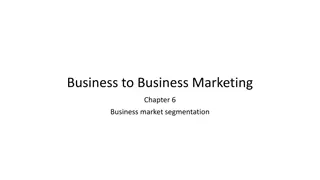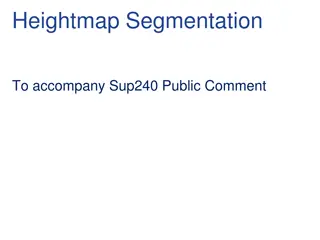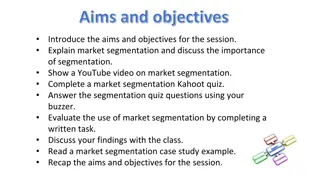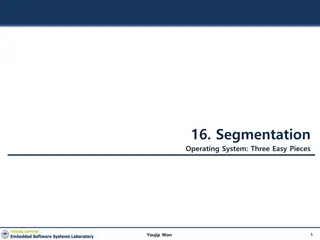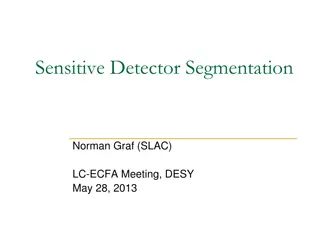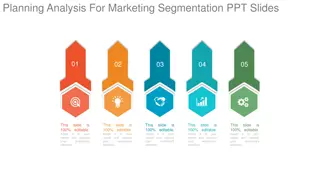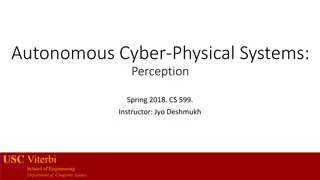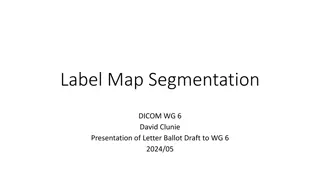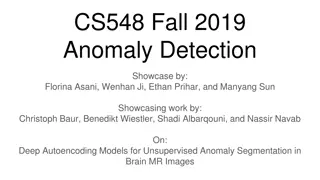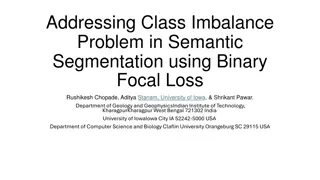
Effective Community Member Segmentation Strategies
Learn how to segment your community audience effectively for targeted engagement. Discover various segmentation methods like demographics, psychographics, geographic, and behavioral characteristics. Utilize the provided templates to build unique outreach messages, user journeys, and personas. Enhance member engagement by catering to specific needs and behaviors within your community.
Download Presentation

Please find below an Image/Link to download the presentation.
The content on the website is provided AS IS for your information and personal use only. It may not be sold, licensed, or shared on other websites without obtaining consent from the author. If you encounter any issues during the download, it is possible that the publisher has removed the file from their server.
You are allowed to download the files provided on this website for personal or commercial use, subject to the condition that they are used lawfully. All files are the property of their respective owners.
The content on the website is provided AS IS for your information and personal use only. It may not be sold, licensed, or shared on other websites without obtaining consent from the author.
E N D
Presentation Transcript
C O M M U N I T Y S E G M E N T S T E M P L A T E
DEVELOPING USEFUL MEMBER SEGMENTS FEVERBEE MEMBER SEGMENT TEMPLATE SEGMENTATION We ve created this resource to help you segment your community audience into clear and visible you can then engage individually. These segments should help you build unique outreach messages, user journeys, personas, and more. point segmenting members by psychographics here if you don t have the technology which will let you segment into unique groups and deliver unique experiences to each of them. The second is value. If the behavior or needs of members doesn t vary much between segments then using that prism to segment members isn t going to yield much value. Typically, the best segments are those members themselves would identify as as they relate to being a part of your audience. As you will notice, there are many ways of segmenting an audience. You can segment an audience by demographics, psychographics, geographic, and behavioral characteristics. It s easy to go down a deep rabbit hole creating increasingly detailed and complex segments. My recommendation would be to selectjust one of the templates you see here and use this as the basis for building your community. The method you use to segment your audience should depend upon two things. We ve provided a breakdown of what a typical segmentation sheet might look like in the next two slides, but the rest is up to you. The first is practicality. Can you actually create and cater to the segments you re developing. For example, there is no 2
ACTIVITY BASED SEGMENTS FEVERBEE MEMBER SEGMENT TEMPLATE SEGMENT IDENTIFICATION BEHAVIOR NEEDS AND DESIRES Looking to resolve a frustration in the quickest amount of time. Arrives at the community via a search result to a discussion post. VISITOR Needs to be notified of additional value placed prominently within the community. Visits the community but doesn t register or log in. Either finds the information and departs or registers to answer a question / contact support / looks elsewhere for an answer. Requires a clear and obvious link to register for the community. Doesn t see any obvious value in visiting the community again. Asked a question, received a response, but hasn t returned since. INACTIVE Not visited the community within the past 3 months May respond to prompts to attend webinars, read useful content. Likely to visit again if they have another question. Outbound messages have to offer clear value. Visits the community to see what s new and look for relevant content and activity. Visited the community within the past 3 months. Doesn t see what they can contribute to the community. Signs up for events but rarely attends. LEARNER Has few questions to ask and doesn t feel they have expertise to participate. Reads major content articles and webinars. Not made an active post within the community within the past 3 months. Occasionally browses the documentation looking for answers. Looking for answers from trustworthy people. Registered for the community within the past 3 months. Registered to ask a question about an immediate problem. Wants to be treated with respect and empathy. NEWCOMER Once they receive an answer, they will only participate again if they have another question to ask. Needs a quick answer to a question. Contributed less than 3 posts within the past 3 months Open to extra value which could be useful. Looking useful examples and ideas they can learn from. Registered for the community 3+ months ago. Visits the community infrequently and responds to post when they might know the answer. IRREGULAR Like feeling helpful. Contributed 1 to 10 posts within the past 3 months. Would be responsive to opportunities to get more engaged in helping others in the community. Reads content and signs up for events and activities. Wants to feel uniquely important to the community team and to the organisation. Registered for the community 3+ months ago. Visits the community daily to answer questions. SUPERUSER Engages directly with the community team on a weekly basis. Strongly motivated by status and access to community team. Contributed 10+ posts within the past 3 months. Participates in private group for community superusers. Identifies with being an expert within the topic.
CUSTOMER RETENTION-LEVEL SEGMENTS FEVERBEE MEMBER SEGMENT TEMPLATE SEGMENT IDENTIFICATION BEHAVIOR NEEDS AND DESIRES Wants a response to a question without feeling dumb for asking an obvious questions. Intimidate by the volume of information in the community. Worried about being overwhelmed. NEW CUSTOMER Using our products for less than a year Drawn to the community by an immediate product problem Looking for examples and guides they can follow. Typically asks for help via customer support or via friends. INTERMEDIATE CUSTOMER Participates in Q&A / long-form content if it s well organised. Would engage more frequently but doesn t feel they have much to share. Will sometimes browse questions and answer if they know the answer. Doesn t see any major benefit in engaging deeper within the community. Using our products for 1 - 2 years Visits frequently to get the latest product news and updates. Needs to see obvious increase in the value of the community to visit more frequently. Concerned about the signal to noise ratio. VETERAN CUSTOMER Visits frequently out of habit to see if there is something new they can learn from. Dislikes the quantity of beginner-level content in the community. Using our products for 2+ years Likes to quickly scan the community and will open several taps at once to respond to relevant questions when they visit. Wants a private place to chat with fellow veterans about advanced-level aspects of the topic.
SPENDING-LEVEL SEGMENTS FEVERBEE MEMBER SEGMENT TEMPLATE SEGMENT IDENTIFICATION BEHAVIOR NEEDS AND DESIRES MICRO-BUYERS SMALL ACCOUNTS INTERMEDIATE ACCOUNTS TOP CUSTOMERS
GEOGRAPHIC SEGMENTS FEVERBEE MEMBER SEGMENT TEMPLATE SEGMENT IDENTIFICATION BEHAVIOR NEEDS AND DESIRES EMEA NA LATAM APAC
AGE SEGMENTS FEVERBEE MEMBER SEGMENT TEMPLATE SEGMENT IDENTIFICATION BEHAVIOR NEEDS AND DESIRES 12 - 18 18 - 35 35 - 50 50 - 75 75
NPS-BASED SEGMENT FEVERBEE MEMBER SEGMENT TEMPLATE SEGMENT IDENTIFICATION BEHAVIOR NEEDS AND DESIRES DETRACTOR PASSIVE PROMOTER
PSYCHOGRAPHIC SEGMENT FEVERBEE MEMBER SEGMENT TEMPLATE SEGMENT IDENTIFICATION BEHAVIOR NEEDS AND DESIRES STAUNCH CONFORMIST MOSTLY CONFORMIST, BUT OPEN TO CHANGE PRIMARILY FOLLOWS THE CROWD LIKES TO EMBRACE NEW IDEAS RADICAL / CONTRARIAN
PSYCHOGRAPHIC SEGMENT FEVERBEE MEMBER SEGMENT TEMPLATE SEGMENT IDENTIFICATION BEHAVIOR NEEDS AND DESIRES INNOVATOR EARLY ADOPTER EARLY MAJORITY LATE MAJORITY LAGGARDS

